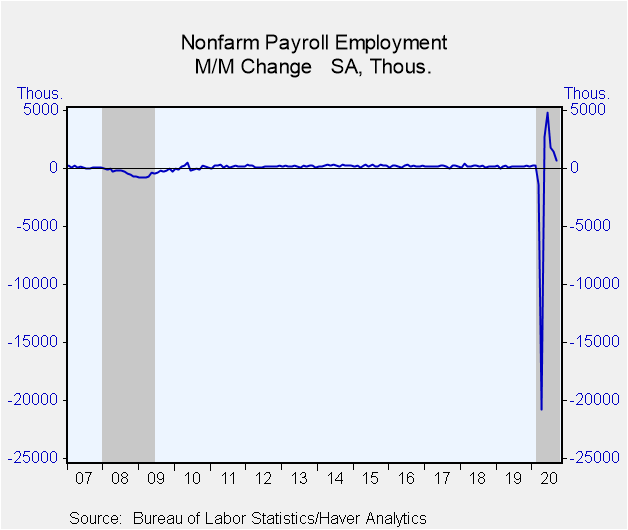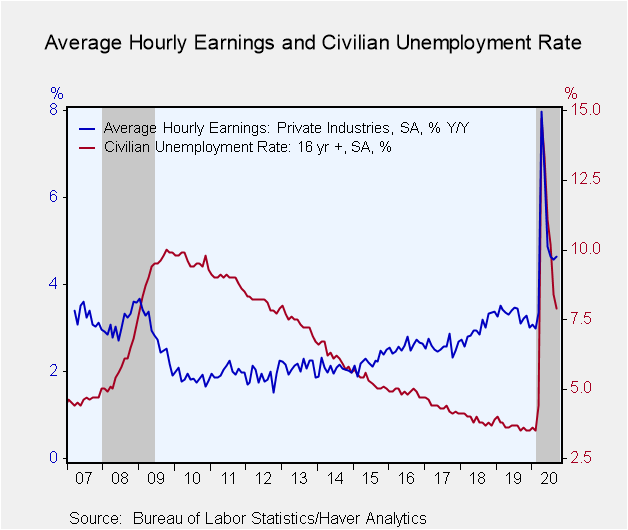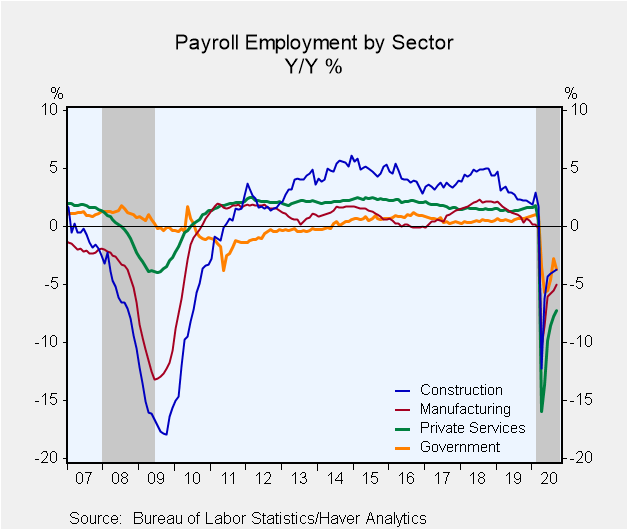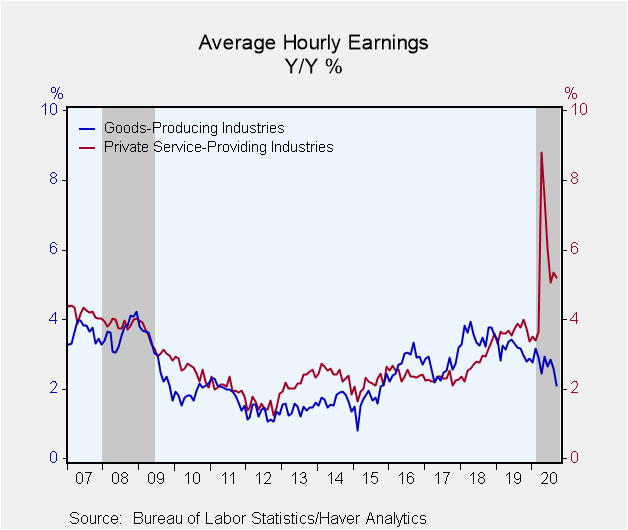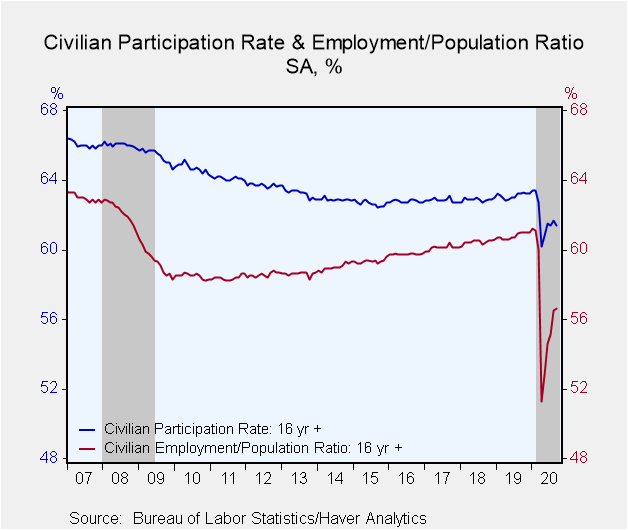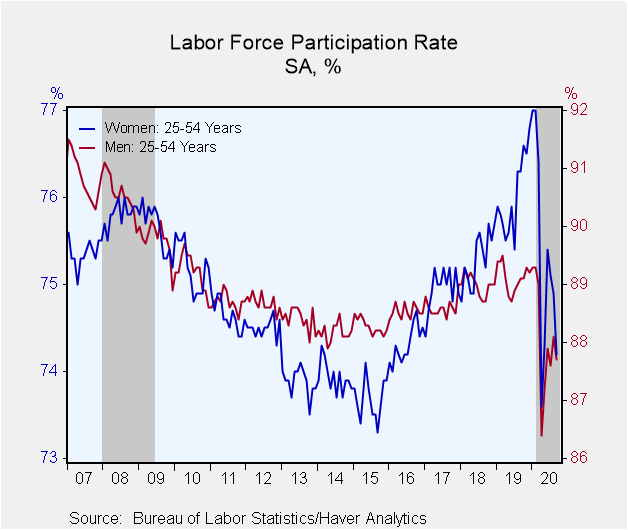 Global| Oct 02 2020
Global| Oct 02 2020U.S. Employment & Earnings Growth Weaken; Jobless Rate Declines
by:Tom Moeller
|in:Economy in Brief
Summary
• Private service-sector hiring slows. • Earnings growth eases. • Jobless rate declines to six-month low. Nonfarm payroll employment increased 661,000 during September (-6.4% y/y) after rising 1.489 million in August, revised from [...]
• Private service-sector hiring slows.
• Earnings growth eases.
• Jobless rate declines to six-month low.
Nonfarm payroll employment increased 661,000 during September (-6.4% y/y) after rising 1.489 million in August, revised from 1.371 million. (Excluding a drop in Census takers, September payrolls rose 702,000.) July employment improved 1.761 million, revised from 1.734 million. Job growth has been positive for five consecutive months, following sharp declines during the economic recession. An 840,000 employment increase had been expected in the Action Economics Forecast Survey. The estimates amongst 26 forecasters had ranged from 400,000 to 1.100 million.
Average hourly earnings growth slowed to 0.1% (4.7% y/y) after a 0.3% August gain, revised from 0.4%. A 0.2% gain in earnings had been expected.
The unemployment rate fell to 7.9% from 8.4%. An easing to 8.2% had been expected. Employment in the household survey increased 275,000 after rising 3.756 million in August while the labor force fell 695,000 after rising 968,000 in August. The overall jobless rate, including those who were marginally attached or working part-time for economic reasons, declined to 12.8% from 14.2%.
From the payroll employment survey, manufacturing sector employment increased 66,000 (-5.1% y/y), the strongest of the last three consecutive increases. Construction employment gained 26,000 (-3.7% y/y) after rising 17,000. Mining & logging employment edged 1,000 higher (-16.1% y/y), the first increase since February.
Private service-sector employment increased 784,000 (-7.2% y/y), the weakest increase in five months. Leisure & hospitality employment grew an improved 318,000 (-21.7% y/y). Trade, transportation & utilities employment strengthened 237,000 (-3.6% y/y) as retail trade employment improved 142,400 (-2.8% y/y), following five months of strong increase. Professional & business service job growth weakened to 89,000 (-5.8% y/y) after a 188,000 rise. Education & health care employment rose 40,000 (-4.7% y/y), down from a 170,000 August increase. Financial sector employment rose a strengthened 37,000 (-1.1% y/y) as it continued to recover from an abysmal April decline.
A decline in federal government hiring due to fewer Census workers lowered federal government hiring by 34,000. Excluding Census takers, overall employment rose 702,000 after improving 1.251 million. State government employment also fell 48,000 (-4.7% y/y) and the number of local jobs declined 134,000 (-6.0% y/y).
Average hourly earnings edged 0.1% higher (4.7% y/y) for the second time in the last three months. Factory sector earnings eased 0.3%, but y/y growth of 3.5% was improved versus 1.7% growth in 2018. Construction sector earnings held steady (3.1% y/y). Private service sector earnings rose 0.1% and a strong 5.0% y/y. Information sector pay eased 0.4% for the second straight month (+3.5% y/y) while professional & business service earnings rose a lessened 0.2% (3.9% y/y). Financial sector earnings gained 0.3% but the y/y increase of 5.9% was up from a 2.7% low in 2017. Education & health services earning rose a steady 0.3% (3.2% y/y) and leisure & hospitably earnings gained 0.2% (2.1% y/y).
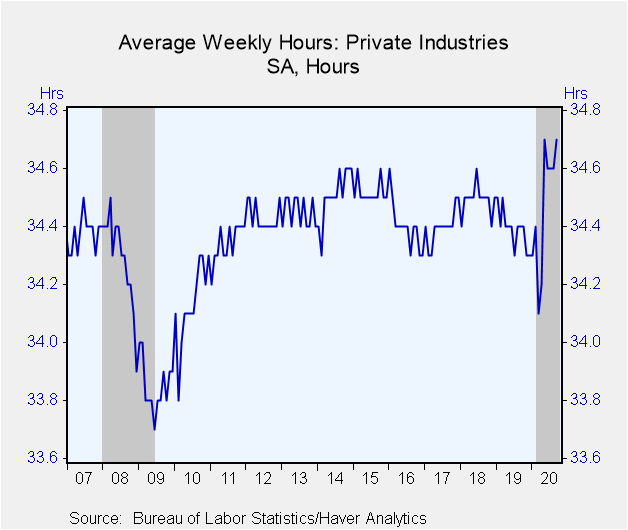 The length of the average workweek extended to 34.7 hours
last month. (Data extends back to 2006.) Mining & logging hours improved to
44.2 and factory sector hours improved to 40.2, up from a 38.0 hour low in
April. Construction sector hours held steady at 38.8 hours. Private service
sector hours improved slightly to 33.7 as financial service hours edged up to
37.6. Professional & business service sector hours were stable m/m at
36.5, but that wasd increased from 35.1 hours during all of 2009. Education
& health services hour surged to a record 33.5 while leisure &
hospitality hours rose to 26.0, up from a low of 24.1 six months earlier.
The length of the average workweek extended to 34.7 hours
last month. (Data extends back to 2006.) Mining & logging hours improved to
44.2 and factory sector hours improved to 40.2, up from a 38.0 hour low in
April. Construction sector hours held steady at 38.8 hours. Private service
sector hours improved slightly to 33.7 as financial service hours edged up to
37.6. Professional & business service sector hours were stable m/m at
36.5, but that wasd increased from 35.1 hours during all of 2009. Education
& health services hour surged to a record 33.5 while leisure &
hospitality hours rose to 26.0, up from a low of 24.1 six months earlier.
From the household survey, the decline in the unemployment rate to 7.9% during September occurred as the labor force participation rate eased m/m to 61.4% and remained down from 63.4% just before the recession began. The teenage participation rate strengthened to 36.2% a seven-month high and for those aged 20-24, it surged to 69.0%, a six-month high. For workers aged 25-54, the rate declined m/m to 80.9%, its lowest since May. For men aged 25-54, the rate slipped to 87.7% and remained down from 89.3% in February. For women of that age, the rate declined sharply to 74.2%, remaining well below its February record high of 77.0%. For workers aged 55 & over, the participation rate eased to 38.9%.
The employment/population ratio for all workers improved m/m to 56.6% in September, up from April's low of 51.3%. It remained, however, sharply lower than January's high of 61.2%. The average duration of unemployment rose to 20.7 weeks, up from 6.1 weeks in April.
The teenage unemployment rate fell sharply to 15.9% from 16.1%. It remained below the record 31.9% in April but stayed much higher than February's 11.0%. The rate for workers aged 20-24 fell to 12.5%, down from the April record of 25.7%. For workers aged 25-54, the rate declined m/m to 7.2%, down from the 12.8% April high. For those over 55, the jobless rate declined to 6.7% and was below the record 13.6% in April.
By educational attainment, unemployment of workers without a high school diploma was 10.6% in September, down from 21.2% in April. High school graduates without any college were 9.0% unemployed last month, down from April's high of 17.3% but higher than 3.6% in February. Those with some college but no degree were 8.1% unemployed, down sharply from the 15.0% April peak but still up from December's near-record low of 2.7%. College graduates experienced a lower 4.8% unemployment rate in September, though it remained significantly higher than its 1.9% low in February.
The employment & earnings data are collected from surveys taken each month during the week containing the 12th of the month. The labor market data are contained in Haver's USECON database. Detailed figures are in the EMPL and LABOR databases. The expectations figures are in the AS1REPNA database.
| Employment (SA, M/M Change, 000s) | Sep | Aug | Jul | Sep Y/Y | 2019 | 2018 | 2017 |
|---|---|---|---|---|---|---|---|
| Payroll Employment | 661 | 1,489 | 1,761 | -6.4% | 1.4% | 1.6% | 1.6% |
| Previous Estimate | -- | 1,371 | 1,734 | -- | -- | -- | -- |
| Manufacturing | 66 | 36 | 41 | -5.1 | 1.2 | 2.0 | 0.7 |
| Construction | 26 | 17 | 31 | -3.7 | 2.8 | 4.6 | 3.6 |
| Private Service-Producing | 784 | 977 | 1,460 | -7.2 | 1.5 | 1.5 | 1.8 |
| Government | -216 | 467 | 235 | -3.7 | 0.6 | 0.5 | 0.4 |
| Average Weekly Hours - Private Sector | 34.7 | 34.6 | 34.6 | 34.4 | 34.4 | 34.5 | 34.4 |
| Private Sector Average Hourly Earnings (%) | 0.1 | 0.3 | 0.1 | 4.7 | 3.3 | 3.0 | 2.6 |
| Unemployment Rate (%) | 7.9 | 8.4 | 10.2 | 3.5 | 3.7 | 3.9 | 4.3 |
Tom Moeller
AuthorMore in Author Profile »Prior to joining Haver Analytics in 2000, Mr. Moeller worked as the Economist at Chancellor Capital Management from 1985 to 1999. There, he developed comprehensive economic forecasts and interpreted economic data for equity and fixed income portfolio managers. Also at Chancellor, Mr. Moeller worked as an equity analyst and was responsible for researching and rating companies in the economically sensitive automobile and housing industries for investment in Chancellor’s equity portfolio. Prior to joining Chancellor, Mr. Moeller was an Economist at Citibank from 1979 to 1984. He also analyzed pricing behavior in the metals industry for the Council on Wage and Price Stability in Washington, D.C. In 1999, Mr. Moeller received the award for most accurate forecast from the Forecasters' Club of New York. From 1990 to 1992 he was President of the New York Association for Business Economists. Mr. Moeller earned an M.B.A. in Finance from Fordham University, where he graduated in 1987. He holds a Bachelor of Arts in Economics from George Washington University.


